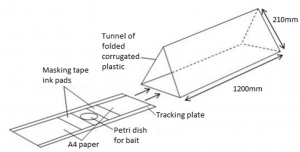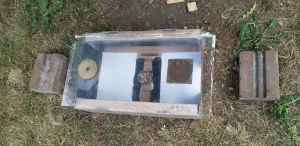July 6, 2020, by sustainablenottingham
What the heck is a hedgehog tunnel?
Hannah Constantin, from the faculty of Engineering and the Hedgehog Friendly Campus group, gives tips and inspiration for engaging with the hedgehogs in your garden.
If you’ve clicked on this article, you’ve taken your first step towards tracking hedgehogs in your own garden! Read on to learn all about it…
What’s the problem?
Hedgehog numbers are on the decline in the UK, dropping approximately 50% since the year 2000. It is difficult to track hedgehogs as they are nocturnal, and notoriously shy. But understanding where hedgehogs are thriving and where they are dwindling is vital to helping them. This is where setting up a hedgehog tunnel is really useful. The next section of this article will document my experiences setting up a hedgehog tunnel, and will hopefully give you the necessarily information and inspiration to do the same. If you don’t have a lot of time on your hands, skip to the last section of this article for some quick hedgehog-friendly tips.
Hedgehog tunnels
The purpose of the tunnel is to identify whether there are hedgehogs in your area. The tunnel includes some meaty pet food to entice hedgehogs, food-safe ink strips, and plain paper. The meaty pet food can be cat or dog food and wet or dry food – the hogs have no preference – as long as it’s dairy free. When the hedgehog enters the tunnel to access the food, it steps on the ink strips, and then onto the plain paper. You’ll know if a hedgehog has entered the tunnel if you can see characteristic hedgehog prints on the plain paper (they are very distinctive; they look like tiny hand prints). Make sure to place your tunnel close to a border (such as a hedge or fence), and position it parallel to the border. Check your tunnel every morning, and where necessary, top up the food and replace the paper and ink. The image below shows an example of the configuration, using corrugated plastic as the tunnel.

Adapted by Emily Thomas from Yarnell et al. 2014
I was very excited to make my first hedgehog tunnel. I made mine from a large cardboard box, as I had one to hand, but you could also use house bricks, corrugated plastic (as shown above), or purchase a tunnel here (https://www.nhbs.com/mammal-footprint-tunnel), which includes everything you need to get started. If you’re using a cardboard box, make sure to weather proof it (I used a bin bag), I was glad I did when we had torrential rain in the middle of the survey! I cut holes in either end of the box to act as doorways. I then stuck two sheets of paper inside the tunnel, next to the doorways. In the centre, I placed a pot of meaty dog food. Either side of the food, I stuck strips of masking tape and painted on a layer of food-safe ink (this was just vegetable oil mixed 1:1 with food-grade charcoal powder). I then placed my completed tunnel in my back garden, next to and parallel to the hedge. It was difficult to wait until the next morning to see if any hedgehogs had visited! Thankfully I had added a perspex roof to the top of my tunnel, so that I could peek at hedgehogs during the night from my bedroom window. I also placed a couple of bricks 10 – 15cm away from each doorway, to try to stop cats from entering.

On the first morning, I was delighted to find hedgehog prints in my tunnel. After changing the paper, topping up the food, and replenishing the ink, I left the tunnel out for another night. Mornings two and three also yielded hedgehog prints, but then the rain came. It must have deterred the hedgehogs, because on morning four, there were no prints. On the fifth and final day of the survey, there were once again hedgehog prints. I made sure to document my findings every morning.

It was a fantastic experience to track hedgehogs; particularly when you find hedgehog prints. If you’d like more information on building a hedgehog tunnel, get in contact using the e-mail address at the bottom of this article.
I can’t commit to this, is there anything quicker I can do to help hedgehogs?
Certainly! Here are a few things you can do that won’t take up too much time:
- Make a 13x13cm hole in your garden fence to allow hedgehogs to roam between gardens
- One step further – ask your neighbours to do the same
- Put a shallow dish of water in your garden for hedgehogs to drink; this is especially important in hot weather
- One step further – put out a dish of meaty pet food (make sure it’s dairy free)
- Caution – don’t offer milk! Hedgehogs are lactose intolerant
- If you have a pile of leaves/grass etc. in your garden, leave it where it is if possible. Hedgehogs could be nesting under the pile. If you plan to burn the pile, make sure you thoroughly check it beforehand
- Better yet – move it first

Written by the Hedgehog Friendly Campus group. Contact hannah.constantin@nottingham.ac.uk for more information.
No comments yet, fill out a comment to be the first

Leave a Reply